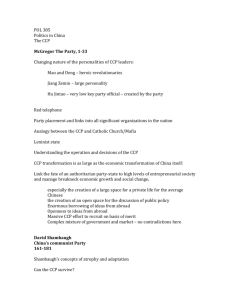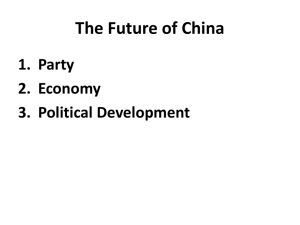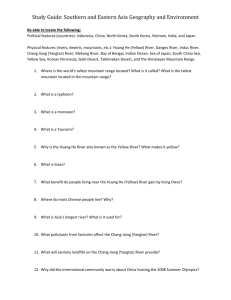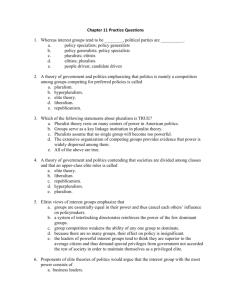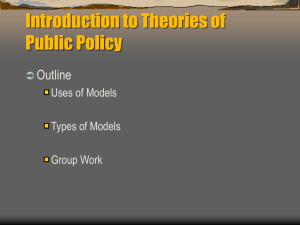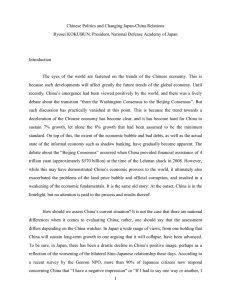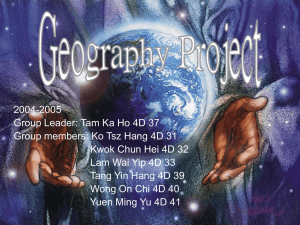Elite Transformation and Institutional Change: The Recent Party
advertisement
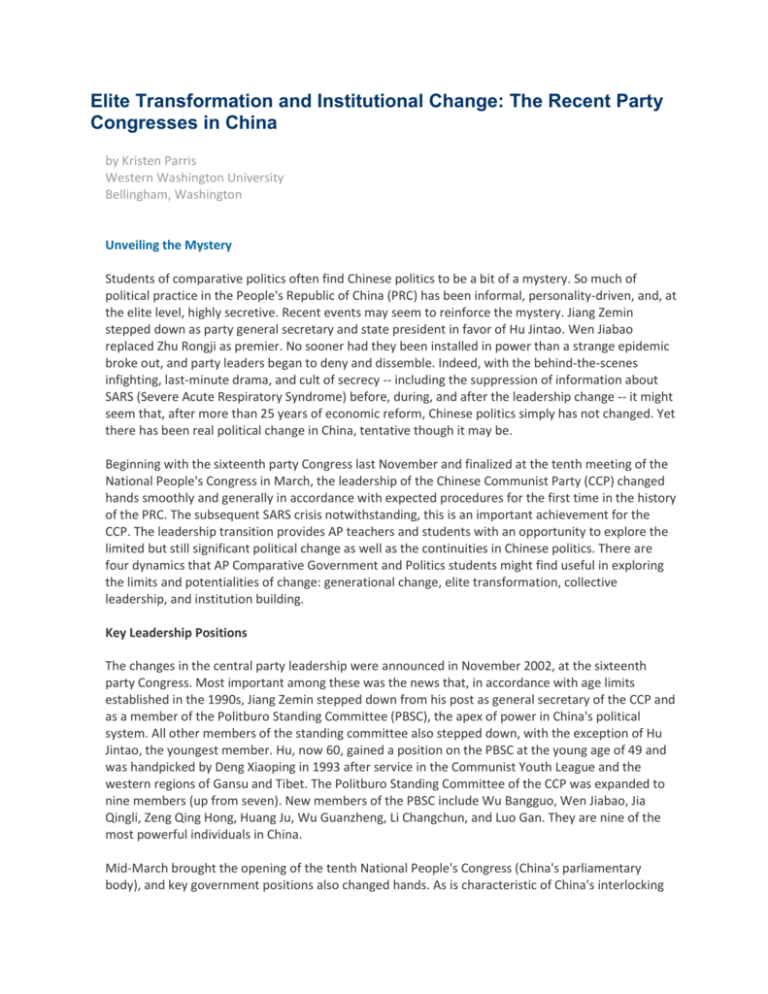
Elite Transformation and Institutional Change: The Recent Party Congresses in China by Kristen Parris Western Washington University Bellingham, Washington Unveiling the Mystery Students of comparative politics often find Chinese politics to be a bit of a mystery. So much of political practice in the People's Republic of China (PRC) has been informal, personality-driven, and, at the elite level, highly secretive. Recent events may seem to reinforce the mystery. Jiang Zemin stepped down as party general secretary and state president in favor of Hu Jintao. Wen Jiabao replaced Zhu Rongji as premier. No sooner had they been installed in power than a strange epidemic broke out, and party leaders began to deny and dissemble. Indeed, with the behind-the-scenes infighting, last-minute drama, and cult of secrecy -- including the suppression of information about SARS (Severe Acute Respiratory Syndrome) before, during, and after the leadership change -- it might seem that, after more than 25 years of economic reform, Chinese politics simply has not changed. Yet there has been real political change in China, tentative though it may be. Beginning with the sixteenth party Congress last November and finalized at the tenth meeting of the National People's Congress in March, the leadership of the Chinese Communist Party (CCP) changed hands smoothly and generally in accordance with expected procedures for the first time in the history of the PRC. The subsequent SARS crisis notwithstanding, this is an important achievement for the CCP. The leadership transition provides AP teachers and students with an opportunity to explore the limited but still significant political change as well as the continuities in Chinese politics. There are four dynamics that AP Comparative Government and Politics students might find useful in exploring the limits and potentialities of change: generational change, elite transformation, collective leadership, and institution building. Key Leadership Positions The changes in the central party leadership were announced in November 2002, at the sixteenth party Congress. Most important among these was the news that, in accordance with age limits established in the 1990s, Jiang Zemin stepped down from his post as general secretary of the CCP and as a member of the Politburo Standing Committee (PBSC), the apex of power in China's political system. All other members of the standing committee also stepped down, with the exception of Hu Jintao, the youngest member. Hu, now 60, gained a position on the PBSC at the young age of 49 and was handpicked by Deng Xiaoping in 1993 after service in the Communist Youth League and the western regions of Gansu and Tibet. The Politburo Standing Committee of the CCP was expanded to nine members (up from seven). New members of the PBSC include Wu Bangguo, Wen Jiabao, Jia Qingli, Zeng Qing Hong, Huang Ju, Wu Guanzheng, Li Changchun, and Luo Gan. They are nine of the most powerful individuals in China. Mid-March brought the opening of the tenth National People's Congress (China's parliamentary body), and key government positions also changed hands. As is characteristic of China's interlocking party-state structure, top party officials also took on top positions in the government. The transition to a new generation was confirmed as Jiang Zemin stepped down from the presidency in favor of Hu Jintao, and China's premier, Zhu Rongji, stepped aside in favor of Wen Jiabao. In addition, new state councilors, vice premiers, and ministerial positions (among others) were confirmed by the National People's Congress. There was not a clean break with the past, however -- Jiang Zemin stayed on as chair of the party Central Military Affairs Commission (CMAC), a powerful position for which there is as yet no agreedupon age limit. Many had speculated that the CMAC chair position would go to Hu Jintao, vice chair since 1999, making him the preeminent leader with all three key leadership positions. Instead, Jiang follows the lead of Deng Xiaoping, who retained this position for two years after stepping down from the PBSC in 1987. How long Jiang will hold this position is unclear, but as leader of China's military, he may be expected to continue to wield considerable power. Generational Change and Elite Transformation In spite of Jiang's continuing role as CMAC chair, this change of leadership represents a generational shift to what the Chinese authorities have termed "the fourth generation" (disidai)of Chinese leaders. Before examining the generational content, it is worth noting the political significance of the concept of the fourth generation. It is, as Cheng Li notes in his book China's Leaders: The New Generation, a highly political categorization, originating with Deng Xiaoping's claim to represent the "second generation" of Chinese leaders after Mao Zedong's Long March generation. It is part of Deng's desire, in the wake of the Tiananmen massacre of 1989, to make a smooth transition to a "third generation" of leaders represented by Jiang Zemin. This formulation seeks to obscure the difficulties involved in political successions in the PRC, which in the past were characterized by the overthrow of leaders amid disruption and controversy, as in the virulent, "winner take all" struggles of the Cultural Revolution and its aftermath. Nevertheless, observers have argued that the generations do share key political experiences and characteristics. The rise of the fourth generation reflects the rise and consolidation of a new technocratic elite. Under Mao, few party leaders had more than a middle-school education, and the party was overwhelmingly made up of peasants. In the early 1980s, Deng Xiaoping's "four transformations policy" sought out party members and promoted cadres who were "revolutionary, young, knowledgeable, and specialized;" Jiang Zemin and Li Peng, both trained as engineers, were among the technocrats of the third generation to be recruited to the central committee in the 1980s. It is possible, however, to discern potentially important distinctions between the third and fourth generations. Jiang Zemin and his cohort came of age during a period of socialist transformation and had their views shaped by the Soviet-inspired industrial drive of the 1950s. The worldview of the fourth generation, born in the 1940s and 1950s, is more likely to be influenced by the Cultural Revolution. Leaders of this new generation are gaining power at a younger age, and although they are less well traveled, they are better educated than their elders (often at China's prestigious universities). Hu Jintao, for example, graduated in 1965 from Qinghua University (known as China's MIT) with a degree in hydroelectric engineering. While the second and third generations of leaders focused on economic growth, making modernization and consumerism the keys to their legitimacy, soon after their installation Hu Jintao and the new premier, Wen Jiabao, indicated a possible shift in focus. Both have already made speeches addressing some of the problems associated with China's rapid economic modernization and globalization drive, including the growing gaps in wealth, rural poverty, the heavy tax burdens on farmers, increasing urban unemployment, and environmental degradation. In addition, their rhetoric clearly plays to a growing public concern about the effects of marketization and globalization at a time when public opinion is playing a small but increasingly significant role in elite politics and transition. From investigative reporting on corruption and poverty in the Southern Weekend to postmodern critiques of the effects of globalization in scholarly journals to jingoistic attacks on U.S. hegemony in Internet chat rooms, party leaders increasingly must respond to the pressure of public opinion. Thus the rhetorical flourishes may reflect a real policy shift. How to promote social welfare and stability while encouraging private investment and growth is the crucial challenge for the new leadership group -- a group that, unlike previous generations, has no dominant figure. Collective Leadership and Institution Building The road from Mao to Hu has been one leading away from the politics of personality cults, strongmen, and winner-take-all power struggles and moving toward collective leadership, compromise, and deliberative decision making. Hu Jintao, as party leader and president, may be the top party official, but he is not the dominant leader. He is the leader of the party and head of state, but he must work together with other party leaders to govern. Unlike Jiang Zemin, who rose to power unexpectedly in the midst of virulent factional infighting during and after the 1989 Tiananmen crisis, Hu came to office in accordance with an established and orderly transition process. Moreover, Hu derives his power and authority primarily from formal party and state positions rather than from personal prestige or charisma or from the power of an elder party benefactor. The norm of collective leadership does not mean that there is consensus among the top leadership, however. While all leaders of the PBSC agree that there must be continued economic and limited political reform, they are divided both by policy differences and personal ambition. Meritocracy and deliberative decision making are all part of a process of institution building intended to constrain ambitions and avoid the destructive power struggles of the past as well as create a more stable basis for CCP legitimacy in the face of a decreasing significance of Communist ideology and the real potential for economic instability. That these norms are highly valued is evidenced by the fact that top leaders all voluntarily stepped down from their posts on the PBSC in accordance with established age limits, offering some hope of a more transparent and predicable government. But this outcome is hardly assured. Indeed, institutionalization remains quite fragile. Emblematic of the limits to the institutionalization process is Jiang Zemin's decision to remain as CMAC chair even though he retired from the PBSC. This position allows him to wield enormous power from behind the scenes. The decision to remain, when all other party leaders over the age of 70 retired from all of their positions, calls into question the very principles of institution building that this party Congress sought to forward. The fact that Jiang stepped down as party leader and president demonstrates that change has occurred; the fact that he remains CMAC chair is evidence of the tenuous nature of the change. Successful transitions require an agreed-upon set of rules, if not a well-developed legal system. Jiang's presence not only constrains Hu Jintao's ability to consolidate his position as the core of the fourth generation, it threatens the completion of a smooth transition and the institutionalization of routine procedures. Although the absence of a single dominant leader among China's new leaders could allow for benefits such as increased pluralism and elite competition, this would only be true if they are accompanied by stronger formal institutions. The fragility of the institutions, the continuing influence of Jiang, and the competing personal ambitions and policy objectives within the new PBSC might result in an increasingly rancorous power struggle that could bring the retired elders back into the decisionmaking process, reversing the tentative progress on institution building -- especially in the face of a significant crisis. Today, it is possible to imagine the spread of SARS and the accompanying scandal as precisely such a crisis for the new leadership. Elite Transformation and Institutional Change: Limits and Possibilities The recent succession represents a potentially important landmark for institution building, but the apparent success of the transition and the potential for promising change that this seemed to herald were almost immediately undercut by the specter of an uncontrolled epidemic spreading throughout China. The leadership failed to respond and, indeed, engaged in a cover-up. The seeds of the crisis were literally germinating and spreading while the new leadership was being announced in November and March. Even as late as April 10, public health officials in Beijing were calming the public with misinformation and even encouraging the public to travel on the upcoming national May Day holiday. The disease spread rapidly. On April 20 the CCP changed its message and admitted that there were nearly 2,000 SARS cases nationwide. In a separate announcement, two high-level cadres, the minister of health and the mayor of Beijing, were removed from their Communist Party posts. Neighborhoods were quarantined, schools closed, and a new expensive hospital complex rushed into operation. Much damage was already done, however. As cases of the sick mounted, the World Health Organization issued warnings against travel to Beijing. China's vast and impoverished hinterland was even more vulnerable, as migrant workers and college students, possibly already infected, returned to their hometowns in an effort to escape the disease. Hu and his cohorts had sought to project the image of modern technocrats concerned with the needs of China's ordinary people. Instead, the new leadership looked both uncaring and incompetent, willing to sacrifice the public health in favor of a tradition of needless secrecy and manipulation. It is not clear whether the bold turnaround in government policy can contain the crisis or repair the damage to the credibility of the new leadership and the party more generally. If the disease is not brought under control quickly, Hu Jintao's position could be in danger: Jiang Zemin and his protégé Zeng could seek to unseat Hu in a new round of behind-the-scenes infighting, bringing China's newly retired elders back into play. There is yet another scenario. In the face of obvious mistakes and the spreading epidemic, Hu Jintao and Wen Jiabao find themselves facing not just factional divisions within the party but also increasing pressure from an outraged public. It is possible that the CCP leadership will choose to embrace greater accountability and transparency in government as a way to increase their own legitimacy. Perhaps, like the newly installed Soviet leader Mikhail Gorbachev, who in 1986 engaged in stonewalling and misinformation in the wake of the Chernobyl disaster, Hu and Wen might ultimately lead the Communist Party toward more fundamental political reform and openness. Of course, SARS is not Chernobyl, and any Chinese Communist Party leader would recoil at a comparison with Gorbachev, who is seen as a traitor to his party and nation. There is certainly no reason to believe that political reform would take a path similar to that of the USSR. Still, as Hu and the new leadership seek to rebound from the crisis, regain credibility, and maintain their own power, a reform that increases transparency and provides some mechanism for accountability may seem to be the best -- or even only -- option. Kristen Parris is an associate professor of political science at Western Washington University, where she teaches comparative politics and East Asian politics and does research on Chinese politics. She is the author of several articles on Chinese politics and is currently working on a book about private business owners in China. She spent the 2001-2002 academic year in Hangzhou, PRC.
